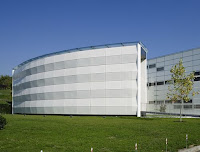
In lieu of todays lecture on digital fabrication, I thought i might investigate some forms created using digital techniques. Perhaps the key point i took from todays lecture is that a structure need not have any digital function to represent the digital world. This is evident in the structures below as all forms have been created using digital software and hardware yet most do not require fancy lighting or touchscreen technology to suggest their digital beginnings.

















